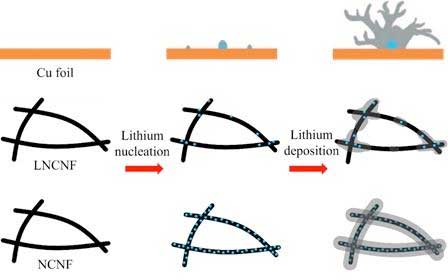| Posted: Jun 20, 2018 |
A lightweight carbon nanofiber-based collector for lithium anodes
(Nanowerk News) Quan-Hong Yang from Tianjin University and Wei Lv from Graduate School at Shenzhen, Tsinghua University with their co-workers reported a lightweight, high nitrogen-doping level carbon nanofiber framework as the current collector for lithium metal anodes, which could restrain the dendrite growth and achieve the uniform lithium deposition. This work is recently published in Science China Materials ("A lightweight carbon nanofiber-based 3D structured matrix with high nitrogen-doping level for lithium metal anodes").
|
 |
| This is a schematic diagram of lithium nucleation and deposition behavior on Cu foil, low nitrogen-doping level carbon nanofiber framework and high nitrogen-doping level carbon nanofiber framework. (© Science China Press)
|
|
Yang's group and Lv's group are still devoted to carbon materials and their applications in energy storage.
|
|
They said "despite the high-energy-density of lithium metal batteries, the intractable dendrite growth resulted in low coulombic efficiency, internal short circuit and even hazardous issues hinder their practical use. Carbon materials can play a significant part in solving above-mentioned problems, enabling the practical application of lithium metal anodes."
|
|
Tremendous efforts have been made to solve the lithium dendrite problem. The conductive three-dimensional framework structures, like the porous Cu current collector and 3D graphene framework, attract great attention because they can lower local current density and accommodate large volume changes during cycling.
|
|
"Despite the excellent structure stability and superior electrical conductivity, the porous metal current collector is heavy, greatly comprising the energy density," Yang emphasized, "the porous carbon framework is lightweight, which benefits to improve the energy density based on the whole device. Yet their non-lithiophilic surfaces are not ideal for the uniform nucleation and deposition of lithium."
|
|
Nitrogen-containing functional groups on carbon framework surface can interact with lithium atoms and enhance the lithiophilicity of the carbon framework. Using polyacrylonitride as the raw material, a lightweight and high nitrogen-doping 3D conductive carbon nanofiber matrix (NCNF) can be easily prepared by electrospinning, pre-oxidation and thermal treatment.
|
|
Yang introduced "the use of NCNF as the current collector has several advantages:
|
|
(1) A light weight matrix can maintain the high specific capacity nature of Li metal anode. The density of NCNF is only 0.57 mg/cm2. When the lithium loading is 4 mAh/cm2, the lightweight NCNF brings about large capacity of 2489.7 mAh/g based on NCNF-Li composite;
|
|
(2) High specific surface area and 3D structure are helpful to lower the local current density and accommodate the large volume changes during cycling;
|
|
(3) High nitrogen-doping guarantees sufficient low nucleation overpotential sites on the large surface of the NCNF, guiding lithium nucleation uniformly and suppressing the growth of lithium dendrite.
|
|
These resulted in excellent cycling stability with a high coulombic efficiency over 98% more than 250 cycles for lithium deposition. Moreover, when paired Li@NCNF anode with LiFePO4 to assemble full cell, reduced voltage polarization and high capacity retention were shown."
|
|
Yang concludes "this work clearly demonstrated the important roles of the heteroatom doping for the modification of carbon surface to realize the uniform and dendrite free metal anode deposition, and also showed great potential of light weight NCNF for the use in metal-based anodes with high energy density."
|

